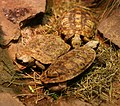This article needs additional citations for verification .(October 2019) |
African reptiles are categorized by reptilian order:
Order Testudines: turtles
| Image | Common name(s) | Scientific name | Distribution | Notes |
|---|---|---|---|---|
 | African spurred tortoise or Sulcata tortoise | Centrochelys sulcata | southern edge of the Sahara Desert | Third largest species of tortoise in the world; the largest non-island species. [1] |
 | African helmeted turtle Marsh terrapin | Pelomedusa subrufa | Very wide range | |
 | Aldabra giant tortoise | Aldabrachelys gigantea | Seychelles | |
 | Angonoka tortoise | Astrochelys yniphora | native to Madagascar | |
| Aubry's flapshell turtle | Cycloderma aubryi | Democratic Republic of Congo, Zaire, Gabon, Angola and theCentral African Republic | ||
 | East African black mud turtle | Pelusios subniger | East Africa | |
 | Geometric tortoise | Psammobates geometricus | Cape area of South Africa | |
 | Leopard tortoise | Stigmochelys pardalis | savannah from Sudan to South Africa [2] | |
| Lobatse hinge-back tortoise | Kinixys lobatsiana | Southern Africa | ||
| African softshell turtle | Trionyx triunguis | parts of East, West and Middle Africa | ||
 | Pancake tortoise | Malacochersus tornieri | most common in Kenya and Tanzania [3] | |
 | Radiated tortoise | Astrochelys radiata | native to southern Madagascar [4] | |
 | Speke's hinge-back tortoise | Kinixys spekii | Tanzania, etc. | |
| Turkana mud turtle | Pelusios broadleyi | Eastern Africa (Kenya, etc.) | ||
| Upemba mud turtle | Pelusios upembae | Democratic Republic of the Congo | ||
 | Yellowbelly mud turtle | Pelusios castanoides | Madagascar, Malawi, Mozambique, Seychelles, South Africa, and Tanzania |
Order Squamata: snakes and lizards
- Acanthocercus
- Acanthodactylus erythrurus
- Acanthodactylus mechriguensis
- Agama (genus)
- Agama agama
- Agama aculeata
- Agama africana
- Agama armata
- Agama caudospinosa
- Agama mwanzae
- Agama rueppelli
- Aspidelaps
- Atheris ceratophora
- Atheris chlorechis
- Atheris desaixi
- Atheris hispida
- Atheris katangensis
- Atheris nitschei
- Atheris squamigera
- Bitis arietans
- Bitis atropos
- Bitis caudalis
- Bitis cornuta
- Bitis gabonica
- Bitis heraldica
- Bitis inornata
- Bitis nasicornis
- Bitis parviocula
- Bitis peringueyi
- Bitis rubida
- Bitis schneideri
- Bitis worthingtoni
- Bitis xeropaga
- Boomslang
- Boulengerina annulata
- Cape Cobra
- Cape Dwarf Chameleon
- Chalcides armitagei
- Chalcides montanus
- Chalcides ocellatus
- Chalcides pulchellus
- Chalcides regazzii
- Chalcides thierryi
- Chamaeleo hoehnelii
- Chamaeleo johnstoni
- Chamaeleo melleri
- Charina
- Common Egg-eater
- Eastern green mamba
- Echis coloratus
- Fischer's Chameleon
- Hemidactylus brookii
- Hemidactylus echinus
- Hemidactylus frenatus
- Hemidactylus mabouia
- Hemidactylus muriceus
- Hemidactylus pseudomuriceus
- Henkel's Leaf-tailed Gecko
- Jackson's Chameleon
- Karoo Dwarf Chameleon
- Lined day gecko
- Madagascarophis
- Mamba
- Mozambique Spitting Cobra
- Naja ashei
- Naja nigricollis
- Namaqua Chameleon
- Nile monitor
- Nucras caesicaudata
- Paranaja multifasciata
- Phelsuma pusilla pusilla
- Psudohaje goldii
- Python anchietae
- Python regius
- Python sebae
- Python sebae natalensis
- Red Spitting Cobra
- Rhamphiophis oxyrhynchus
- Rhampholeon spectrum
- Rhampholeon brevicaudatus
- Rinkhals
- Rosette-Nosed Chameleon
- Savannah monitor
- Sharp-nosed Chameleon
- Small-spotted Lizard
- Spitting cobra
- Strange-nosed Chameleon
- Trachylepis striata
- Uromastyx geyri
- Uroplatus
- Uroplatus guentheri
- Uroplatus lineatus
- Uroplatus phantasticus
- Uroplatus fimbriatus
- Uroplatus silkorae
- Varanus albigularis
- Varanus albigularis angolensis
- Varanus albigularis microstictus
- Varanus albigularis ionidesi
- Varanus griseus
- Vipera monticola
- Western green mamba
- Yellow-throated day gecko
Order Crocodilia: crocodiles